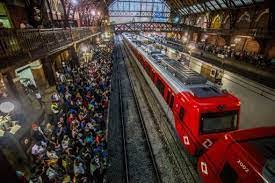
The Brazilian government is considering adopting zero fares on public transport, but experts warn that the measure could put pressure on the system and make it difficult to finance new subway and passenger train projects.
We know that public transport in Brazil, especially in urban areas, is an important issue for workers. At this moment, we are conducting a detailed assessment of the sector at the president’s request,” said Finance Minister Fernando Haddad said in an interview with the state-owned Empresa Brasil de Comunicação (EBC).
“There are several studies being resumed by the Ministry of Finance to see if there are more appropriate ways to finance the system,” said Haddad.
According to the minister, the government will study the sector’s costs, how much the government allocates in subsidies, how much companies contribute through transportation vouchers, and how much comes directly from workers’ pockets. Furthermore, the minister emphasized that it will be necessary to understand “technological bottlenecks and opportunities for innovation.”
Public transport in Brazil consists mainly of a bus network, as well as subways and passenger trains.
However, according to industry executives, the adoption of free services needs to be carefully evaluated to avoid adverse impacts.
“In practically every country in the world, public transportation fares are subsidized in some way by governments; passengers never pay the full cost. What we need to evaluate are the broader effects of this change. Free transportation tends to generate a rapid increase in passenger numbers, which can overload the existing system,” Joubert Flores, chairman of the board of the National Association of Rail Passenger Transporters (ANPTrilhos), told BNamericas.
“Today we already have subway lines in some locations operating under strain, mainly in the metropolitan region of São Paulo,” he observed.
Flores emphasized that, with passenger volume likely to grow significantly, it will be necessary to expand the number of train and subway lines, which involves financing and execution challenges, since subway and metropolitan train projects historically take years to complete.
“I’m not against [zero fares], but I think that, in order to adopt this, we have to evaluate and improve three aspects in relation to the projects and the sector in general: governance, subsidies and financing models,” said Flores.
In recent years, rail transport in Brazil has seen a gradual increase in passenger numbers, but has not yet recovered to pre-COVID-19 pandemic levels, when social distancing measures and the rise of hybrid work reduced demand.
Despite this, the country still has a large deficit in rail passenger transport, which opens up space for new projects, especially in the most populous state, São Paulo.
Political Aspects
The zero-fare proposal comes on the eve of an election year. President Luiz Inácio Lula da Silva, of the Workers’ Party (PT), is expected to run for reelection in October 2026, when Brazilians will go to the polls to choose president, governors, deputies, and senators.
The issue of public transport has strong political and historical appeal in the elections.
In 2013, the increase in bus fares in several cities sparked large popular demonstrations, which later expanded to include issues such as the fight against corruption.
These protests directly affected the image of the government of then-president Dilma Rousseff, also from the Workers’ Party (PT), and, according to analysts, were one of the triggers for the political process that culminated in Operation Car Wash and Rousseff’s impeachment in 2016.
Other Projects
While the debate over free public transportation continues, several subway projects continue to be developed across the country.
The federal government, through the Ministry of Cities, authorized the second stage of revitalization and modernization works on the Teresina subway, in the state of Piauí.
The total investment is 351.2 million (mn) reais (US$65mn), of which 237.9mn reais comes from the federal government, via the general budget and 113.3mn reais is a state counterpart.
Among the main interventions are the implementation of three new stations, Piçarra, São João and Mafuá, the requalification of existing stations and the duplication of the crossing over the Poti River, with the construction of a new bridge.
Work is also planned to lower Avenida Higino Cunha, build a railway viaduct and redevelop the area around all stations, in addition to completely sealing the line.
Inaugurated in 1990, Teresina’s metro began operating with part of its original design incomplete, lacking connections to the city center, with few stations and a limited fleet. With the new construction, the government hopes to offer a more efficient service to the population.
At the same time, in Minas Gerais, the state government announced progress on expansion projects for the Belo Horizonte subway, which currently operates under a concession regime.
According to the government, the expansion work on Line 1 is already 85% complete and is scheduled for completion in January 2026. Work on Line 2 is expected to be completed by 2028, adding 10.5 kilometers of extension and seven new stations.
(The original version of this content was written in Portuguese)





